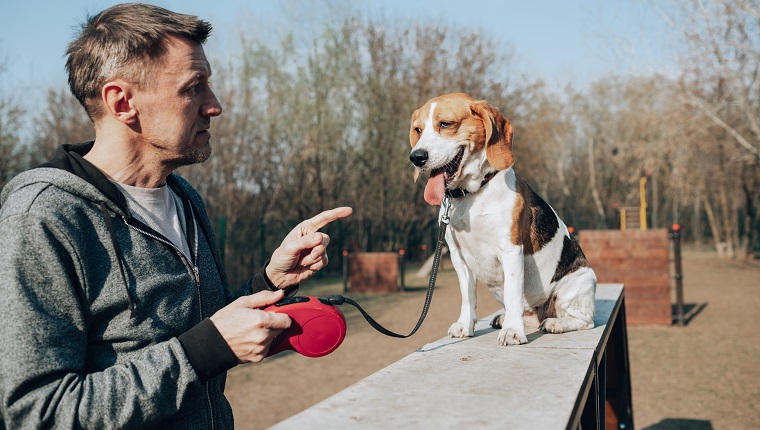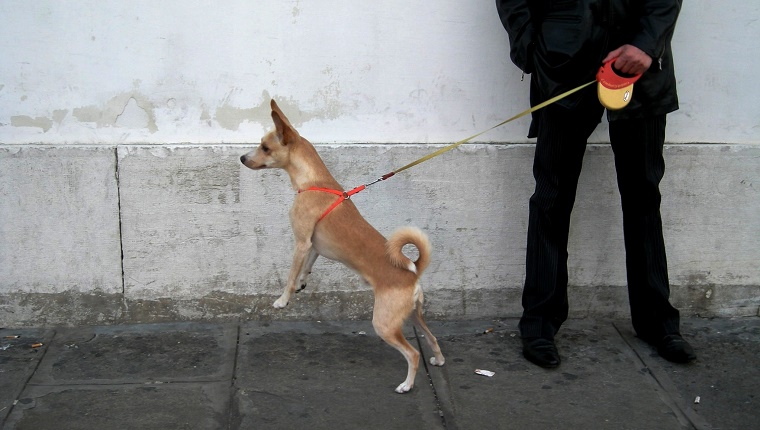Consumer Reports first sounded the alarm, “Retractable leashes pose problems for people and their pets,” and it’s no exaggeration. Retractable leashes are wildly popular and are sold at every pet store or available online.
People often choose them thinking they will give their dogs extra freedom to sniff and poke around on walks. Unfortunately, the upsides to this type of leash are far outweighed by the risks they pose.
Here’s what you should know about the dangers of retractable leashes for both humans and dogs.
What Is A Retractable Leash?

A retractable leash is often a thin length of cord wrapped around a spring-loaded device housed inside a plastic handle that fits comfortably in a human hand. A button on the handle controls the amount of cord that extends.
As that cord pulls out, the dog is less confined to walking beside you. Some cords extend up to 26 feet.
Many of these leashes don’t come with standard loops that fit around wrists, as you see with traditional leashes. It’s far easier to accidentally drop a retractable leash for this reason.
A dog at the end of a retractable leash can get far enough away from their human to get into trouble–able to run into the street or to make uninvited contact with other dogs and people. If your dog is on a retractable leash and approached by an aggressive dog, it’s hard to get control of the situation.
It’s easier to protect an animal on a standard leash than one 20 feet away at the end of a thin cord.
Too often, that cord can snap from the pull of a powerful dog. Even sturdier or thicker retractable leashes can extend dangerously quickly and are still held by the mechanism inside the grip. You are not actually holding the leash–you are holding a device that holds the leash.
What Dangers Do Retractable Leashes Pose To Humans?

When a retractable leash cord breaks, it can cause injury, often to the human at the other end.
If the human grabs the cord in an attempt to reel in their dog, then serious injuries can follow. People who have instinctively grabbed the cord have suffered burns, cuts, and even immediate amputation of a finger.
The same thing can happen if the leash wraps even once around a limb or finger. If a dog takes off when that happens and pulls ten to 20 feet of leash, the cord can generate a lot more friction than a short, traditional leash can. The tension and friction from that thin cord can do a lot of damage and result in severe injuries.
Many people have been pulled off of their feet by dogs who reached the end of their cords and kept going. All that momentum they build up means a harder pull when they finally do get to the end of the leash.
When this happens, or if a person gets tangled up in the leash, it frequently means a fall. That can cause injuries like “road rash,” scrapes, bumps, bruises, broken bones, or worse.
What Dangers Do Retractable Leashes Pose To Dogs?

Dogs have also been seriously injured by retractable leashes. When the leash runs out of line, there is a sudden jerk on the animal’s neck that may cause neck wounds or burns, lacerated tracheas, or spinal injury.
Dogs have been hit by cars darting into the road at the end of retractable leashes–still on their leads, but getting into accidents. Others have been injured getting tangled up with other dogs and bicycles.
There have been cases of dogs getting twisted in the cord and having a tail or leg amputated by the deep cut made when the cord retracts. These things happen quickly, often too fast for the handler to react.
Furthermore, the bulky handle of a retractable leash can be pulled out of the hand by a dog intent on going their own way. That can mean a runaway dog. As if that in itself isn’t dangerous enough, the sound of the handle dropping also scares many dogs and signals them to run.
If the leash is retracting as the dog bolts, then the handle can gain on the frightened animal and make them run faster, or it can strike and injure them. You and your dog may be lucky enough to get through this without injury, but it could also create a lingering fear in the animal–not only of the leash, but of being walked. Who could blame them?
Retractable Leashes Have A Place–And They’re Not For Everyday Use
By their nature, retractable leashes teach dogs to pull when they’re on leash because dogs quickly learn that pulling extends the lead. Dogs should learn to walk politely on a regular leash and stay close enough to their humans to be safe.
These leashes have a tendency to wear out and, over time, will malfunction. The leash may refuse to extend or retract, or could unspool at will.
Traditional leashes get wear and tear, too. However, weaknesses in the lead are easier to spot, as they aren’t hidden in the handle’s casing. If you need to replace your traditional leash, then you’ll likely know, as you’ll be able to see it.
Renowned dog-training expert Cesar Millan has a strong opinion on use of retractable leashes. He says, “Retractable leashes have a specific purpose. They were designed for certain types of tracking and recall training with dogs. You should NEVER use such a lead for just walking your dog.”
For your safety and that of your canine friends, please dispose of retractable leashes and switch to conventional ones.
Related Articles:





